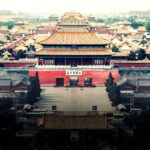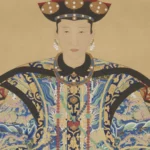The Han Dynasty was a significant period in Chinese history that lasted from 206 BCE to 220 CE. During this time, China experienced significant advancements in various aspects of its culture and society. One notable area that thrived during the Han Dynasty was pottery. The art of pottery flourished, showcasing incredible craftsmanship and unique styles that are highly valued and admired to this day.
Explore More: Discover fascinating insights into Han Dynasty History in our previous article on the Han Dynasty (206 BCE-220 CE). Click to delve deeper into the rich historical context!
Stylistic and Historical Development
The development and evolution of pottery styles during the Han Dynasty were fascinating. The Han Dynasty can be divided into two main periods: the Western Han (206 BCE-9 CE) and the Eastern Han (25-220 CE). These periods witnessed a shift in pottery styles due to various cultural, social, and political factors.
During the Western Han period, pottery production primarily focused on utilitarian items such as jars and vases. These items were often made using stoneware and were known for their practicality and durability. They were widely used for storage purposes, transporting goods, and even as containers for food and beverages.
As the Eastern Han period began, there was a noticeable shift towards more ornamental and decorative pottery pieces. The production of intricate figurines, such as the popular “Kneeling Attendant Figure,” became prevalent during this time. These figures, crafted with intricate details and fine craftsmanship, were often found in tombs and were believed to serve the deceased in the afterlife.
Han Dynasty Pottery – 202BC-220AD
Among the plethora of pottery items produced during the Han Dynasty, one notable example is the Stoneware Jar Pot vase Glazed Vietnam Occupation Antique Original Chinese Porcelain Antique. This particular piece dates back to the Han Dynasty, specifically between 202 BCE and 220 CE. It showcases the exceptional skill of Han Dynasty artisans in creating stunning glazed pottery.
The Stoneware Jar Pot vase is a testament to the high level of craftsmanship and attention to detail that the Han Dynasty potters possessed. With its beautiful glaze, this piece exemplifies the use of vibrant colors and intricate patterns that were characteristic of Han Dynasty pottery. It is a tangible representation of the rich artistic heritage of this era, providing us with a glimpse into the past.
Authentic Han Dynasty (206 BC-220 AD) Green Glazed “Hu” Pottery Jar 30.5 inches tall w/ COA Authentic Chinese Han Artifact -Stunning!
Another remarkable example of Han Dynasty pottery is the Authentic Han Dynasty (206 BC-220 AD) Green Glazed “Hu” Pottery Jar. This exceptional piece stands tall at 30.5 inches and is truly stunning. With its perfectly preserved green glaze, this pottery jar is an extraordinary artifact from the Han Dynasty.
The intricate details and exquisite craftsmanship of the Green Glazed “Hu” Pottery Jar highlight the skill and expertise of Han Dynasty artisans. This large jar’s elaborate design and beautiful glaze demonstrate the Han Dynasty’s commitment to producing pottery pieces that were not only functional but also aesthetically pleasing.
Authentic Han Dynasty Pottery Kneeling Attendant Figure ca 206 BCE to 220 CE with COA and Provenance 6.7 inches in height
An additional noteworthy example of Han Dynasty pottery is the Authentic Han Dynasty Pottery Kneeling Attendant Figure. Standing at a height of 6.7 inches, this small figurine is a testament to the exceptional talent of Han Dynasty artists in creating intricate ceramic sculptures.
The Kneeling Attendant Figure reflects the societal customs and beliefs of the Han Dynasty. These figurines were commonly found in burial sites, and it was believed that they would serve the deceased in the afterlife. The careful attention to detail in this small piece, from the facial features to the delicate folds in the clothing, showcases the mastery of Han Dynasty potters in capturing human forms within their pottery.
Han Dynasty Chinese Coin, 118 BCE, Imperial China – Genuine Ancient Coin in Display Box – History Hoard
While not directly related to pottery, the Han Dynasty Chinese Coin provides valuable historical context. Dating back to 118 BCE, this genuine ancient coin represents the monetary system and economic prosperity that prevailed during the Han Dynasty.
Coins like this played an essential role in the Han Dynasty’s trade and commerce, facilitating economic growth and exchange. They were minted using intricate techniques and often depicted emperors and other symbolic images. The Han Dynasty Chinese Coin serves as a reminder of the rich history and cultural significance associated with this era.
Han Dynasty 1-3rd Century Stoneware miniature Pot jar Vietnam Occupation Antique Original Chinese Porcelain Ancient
The Han Dynasty also produced a wide range of miniature pottery items. One notable example is the Han Dynasty 1-3rd Century Stoneware Miniature Pot Jar. Despite its size, this antique piece encapsulates the essence of Han Dynasty pottery.
These miniature pots were often used for various purposes, ranging from storing medicinal herbs to serving as decorative pieces. The intricate designs and detailed craftsmanship of these miniature jars showcase the Han Dynasty’s commitment to producing pottery that was both functional and visually appealing.
Han Dynasty, A Pair of Antique Chinese Pottery Granary Jars
The Han Dynasty is known for its impressive pottery vessels, including the Antique Chinese Pottery Granary Jars. These jars were used primarily for storing grain and other food items during the Han Dynasty.
These jars exhibit exceptional craftsmanship and durability, making them essential household items in that era. The intricate patterns and designs on the jars further exemplify the Han Dynasty’s dedication to incorporating artistry into everyday objects.
Large Authentic Han Dynasty, ca. 206 BCE to 220 CE Polychrome Tripod Brazier 10.4″ w/ COA and Provenance Authentic Chinese Han Artifact
Among the vast array of pottery items from the Han Dynasty, the Large Authentic Han Dynasty Polychrome Tripod Brazier stands out due to its size and significance. Measuring approximately 10.4 inches, this brazier represents the ingenuity and artistry of the Han Dynasty potters.
The polychrome design of this brazier, featuring a combination of vibrant colors, showcases the advanced techniques used during the Han Dynasty. The tripod structure adds to its functionality, allowing for stable support and efficient heat distribution. This remarkable pottery item is a testament to the diversity of styles and forms produced during the Han Dynasty.
Chinese Art of The Qin and Han Dynasties
[youtube v=”c4FZ7dAKewY”]
The Metropolitan Museum in New York recently showcased a rare exhibition featuring treasures from ancient China. This exhibition focused on the art from the Qin and Han dynasties, which spanned from 221 BC to AD 220. One of the highlights of the exhibition was the world-famous terracotta soldiers, which were discovered in the 1970s in Xi’an.
The exhibition included over 160 objects, most of which had never been displayed in the West before. These objects were sourced from 32 museums across China, representing 13 provinces. The exhibition aimed to showcase the art and culture of the Qin and Han dynasties, as well as the process of unification and the establishment of a centralized political institution in China.
Before the Qin Dynasty, China was divided into different warring states. However, the Qin Dynasty brought about radical reforms and military strength, which allowed them to defeat their rivals and establish the first centralized empire in China. Some of the key reforms introduced by the Qin Dynasty include standardized currency, weights and measures, and a uniform system of writing.
The exhibition displayed original artifacts from the time period, with the exception of two models of chariots that were used by the emperor himself. These artifacts provided insight into the lifestyle and beliefs of the Qin and Han dynasties. For example, they showcased the belief in an afterlife, as emperors would start building their tombs as soon as they gained power.
One of the most well-known pieces in the exhibition was a jade suit, made up of over 2,000 pieces of jade knitted together with gold wires. The Chinese believed that jade had magical properties and could protect the body from decay, allowing the soul to stay intact forever. They even created small plugs made of jade to keep the essence of life from escaping through the body’s openings.
The exhibition also highlighted the importance of music and wine in the Han period. A brick provided images of a luxury banquet, showcasing acrobats, dancers, and musicians. Music and wine were not only used for entertainment but also for important rituals and ceremonies. The exhibition also featured a wine retriever, which was used to easily retrieve wine from a large container and pour it into a cup.
The exhibition revealed the connection between Chinese and Greek art during the Qin Dynasty, with evidence of influences from Greek sculptures. This highlights the global connections and exchange of ideas that were happening even 2,000 years ago.
Other artifacts showcased in the exhibition included lacquer dinnerware, textile fragments showing advanced silk weaving techniques, and mirrors with important characters identifying China as the central kingdom.
Overall, the exhibition provided a unique opportunity to learn about and appreciate the art and culture of the Qin and Han dynasties. It highlighted the complexities of ancient Chinese civilization and its lasting influence on China for over two millennia.
Han Dynasty, A Pair of Antique Chinese Green Glazed Pottery Jars
Green glazed pottery jars, such as the ones originating from the Han Dynasty, are highly sought after by collectors worldwide. These jars were known for their distinctive green glaze that gives them a unique character.
The Antique Chinese Green Glazed Pottery Jars from the Han Dynasty exemplify the Han Dynasty’s dedication to achieving perfection in glazing techniques. The vibrant green color and smooth texture of these jars make them highly desirable among pottery enthusiasts. They are a true reflection of the artistic achievements and cultural significance of the Han Dynasty.
In conclusion, the Han Dynasty was a period that witnessed remarkable advancements in pottery. From the utilitarian stoneware jars to the intricate figurines, the pottery of the Han Dynasty exemplifies the artistry and creativity of the era. These pottery pieces provide us with a tangible connection to the past, offering insights into the lives, beliefs, and cultural richness of the people during the Han Dynasty.
FAQs:
- What is the significance of Han Dynasty pottery?
Han Dynasty pottery holds immense historical and cultural significance. It showcases the craftsmanship, artistry, and technological advancements of the era. These pottery pieces provide valuable insights into the daily lives, customs, and beliefs of the people in the Han Dynasty. - Where can one find authentic Han Dynasty pottery?
Authentic Han Dynasty pottery can be found in reputable galleries, museums, and private collections. It is essential to ensure proper authentication and provenance when purchasing such artifacts to ensure their legitimacy. - What materials were commonly used in Han Dynasty pottery?
Han Dynasty pottery was predominantly made using stoneware. Glazes were also utilized to enhance the aesthetics and durability of the pieces. The use of these materials contributed to the longevity and preservation of Han Dynasty pottery. - Are Han Dynasty pottery items rare?
Due to their historical significance and limited production, Han Dynasty pottery items are considered rare. Their rarity and cultural value significantly contribute to their desirability among collectors and enthusiasts. - How did Han Dynasty pottery influence subsequent pottery traditions?
Han Dynasty pottery served as a significant influence on subsequent pottery traditions in China. The techniques, styles, and designs developed during this era laid the foundation for future ceramic art forms, leaving a lasting legacy on Chinese pottery.
- SYBAU See You Baby Meaning: Gen Z Slang Evolves - July 1, 2025
- Unlock Your Inner Youth: Lifestyle Secrets for a Vibrant Life - July 1, 2025
- Decode SYBAU Meaning: Gen Z Slang Explained - July 1, 2025






